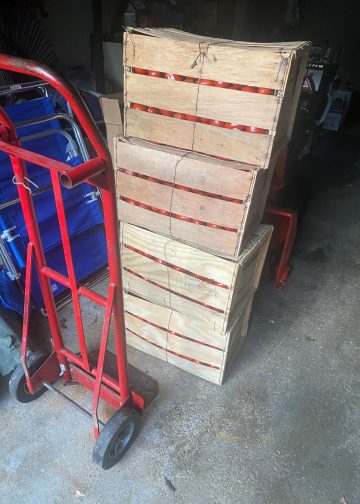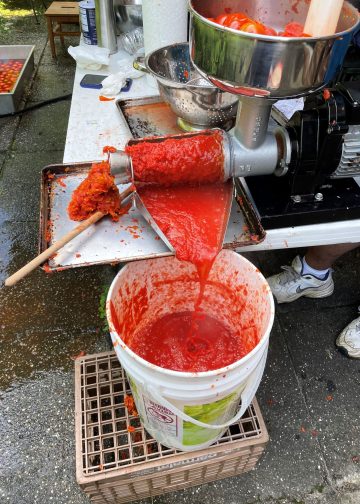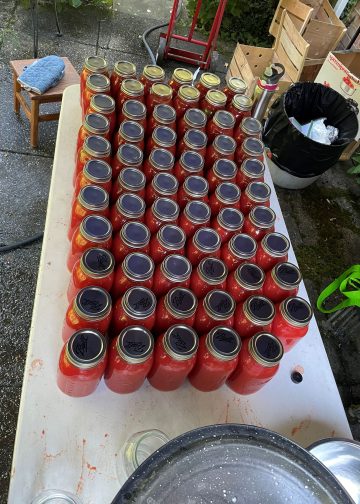For most Americans, August represents the last gasps of summer leading up to Labor Day, where every weekend prior to that is treasured as another opportunity to hang out poolside, chill at the beach, or relax at the lake. But for many Italian Americans, late summer means one thing: Tomato Time!
Each year, tons of tomatoes are either purchased by the crate or handpicked by the bushel in preparation for the annual tradition of Tomato Day, where Italian American families gather to prepare jarred tomatoes for the year’s pasta dinners.
So, why do it and what’s the big deal, you may ask? Everything.
The whole idea shows off a little bit of what makes Italian Americans so special. It’s part pragmatism, part self-reliance, part ritual, and part tradition—all qualities that we as a group are known for.
 I have tremendous memories of tomato day from my childhood; particularly going out to Melnick’s farm on Long Island and picking the bushels by hand–much like my family had spent decades working in the fields of Campania before they immigrated to this country.
I have tremendous memories of tomato day from my childhood; particularly going out to Melnick’s farm on Long Island and picking the bushels by hand–much like my family had spent decades working in the fields of Campania before they immigrated to this country.
While the process is simple, it becomes labor intensive due to the sheer number of tomatoes that are used. A crate/bushel typically weighs 55 pounds, and most families buy anywhere from 4 to 25 bushels depending on how much puree they want and how many people are involved. One crate can typically produce on average, sixteen to eighteen quart-size jars of puree.
After procuring the tomatoes (plum tomatoes are the best as they have a very pulpy flesh, ideal for crushing), the work begins. The tomatoes are first washed (via garden hose, naturally) and each tomato is individually inspected for blemishes or rot.
The offending areas are cut out and the rest are then rinsed in another tub. Some people prefer to slice the tops of the tomatoes off (where they were hanging from the plant) and then cutting them in half; others leave them whole. From there, the tomatoes are blanched in large pots of boiling water over fires; some build wood fires, others use burners fueled by propane.
 These blanched tomatoes are then strained in a sieve or a colander to allow all the excess water to drain out so that the resulting puree is not diluted.
These blanched tomatoes are then strained in a sieve or a colander to allow all the excess water to drain out so that the resulting puree is not diluted.
Next, the tomatoes are run through a spremipomodoro—a tomato mill that is usually electrically powered with a motor that crushes the tomatoes and simultaneously extrudes the seeds and skins so that they do not contaminate the puree. The skins are typically run through the machine at least once more as the first pass does not remove all of the pulp and you can often get almost as much volume out of this pass as you did from the first one.
Once the crushing process is complete, it is time to jar the product. But before this happens a decision is needed; do you jar the puree as is or do you cook it down for a few hours over a fire to thicken it and produce more of a sauce type consistency? As anything, it depends on your preferences and your traditions (our tomatoes go right into the jars). Some people jar the whole plum tomatoes, unpressed or strained.
The most commonly used vessel in the United States for this is the Mason Jar; you will sometimes see other types used in Italy. The jars are sterilized with extremely hot water, either in the kitchen sink or in the dishwasher, then arranged in rows and columns to accept the hot liquid.
 Again, another choice is made—additive free or, in my case, fresh basil and salt. The jars are then fitted with lids and rings to keep the lids in place in preparation for sealing, except for some that are reserved for that evening’s traditional pasta dinner as a reward for a hard day’s work.
Again, another choice is made—additive free or, in my case, fresh basil and salt. The jars are then fitted with lids and rings to keep the lids in place in preparation for sealing, except for some that are reserved for that evening’s traditional pasta dinner as a reward for a hard day’s work.
The jars are sealed in a water bath, which creates a vacuum inside the jars that forces the lids to seal tightly across the jars’ openings.
This is done to prevent spoilage and to preserve the tomatoes for years, generally in a dark place on shelves in the basement or in a cabinet that’s away from heat. I wouldn’t know though because we always wind up using all the jars within the year.
In my memories, I probably ate as many tomatoes as I picked at Melnick’s farm when we got ready for tomato day; my brother jokes they should have weighed us when we arrived and weighed us when we left, then charged us by the pound.
Anything I can do to keep alive the old memories of my family, especially those that are no longer with us, is something worthwhile. There’s also a great sense of pride and accomplishment in looking at the results of a lot of hard work and that it’s done in the service of feeding your family.












